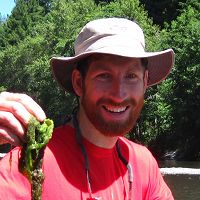Bouma-Gregson, 2017
The Ecology of Benthic Toxigenic Anabaena and Phormidium (Cyanobacteria) in the Eel River, California
Bouma-Gregson, Keith (2017)
University of California, Berkeley
-
Eel, INVESTIGATOR, COLLABORATOR
Abstract
Cyanobacteria are ubiquitous in aquatic ecosystems across the earth. In many environments they
are present at low abundances, however under certain environmental conditions cyanobacteria
bloom and become one of the dominant organisms in an waterbody, degrading aquatic food
webs and water quality. Cyanobacteria evolved over 2 billion years ago, and cyanobacterial
harmful algal blooms (cyanoHABs) have been documented for decades. Of particular concern is
the production of cyanotoxins, secondary metabolites toxic to humans and other organisms, by
certain strains of cyanobacteria. Most research of cyanoHABs has been of planktonic blooms in
lakes or estuaries, and cyanotoxin production by benthic cyanobacteria in rivers has been more
recent, but in many rivers benthic cyanobacteria are the primary source of cyanotoxins. With
field surveys and monitoring, manipulative field experiments, and genome-resolved
metagenomics, this dissertation investigated the ecology of benthic cyanobacteria in the Eel
River, California.
Like most coastal rivers in Northern California, the Eel River is in a Mediterranean climate.
During the seasonal summer drought rivers become shallow, slow flowing, and warm, excellent
habitat for benthic algal production. Non-toxic benthic algae are consumed by vertebrate and
invertebrate grazers and are foundational to the aquatic summer food web. However, these
benthic algal assemblages can tip towards toxicity when cyanobacteria begin to dominate the
assemblage. Over a dozen dogs have died in the Eel River since the year 2000 due to ingesting
cyanobacteria. Neighboring watersheds have also experienced dog deaths from cyanotoxin
poisoning, and benthic cyanobacterial mats are an increasing public health concern in multiple
Northern California rivers. Prior to this dissertation there were few data on the distribution and
ecology of benthic toxigenic cyanobacteria in California rivers.
During the summers of 2013-2015, I documented spatial and temporal patterns of
cyanobacterial occurrence and cyanotoxin concentrations in the watershed, showing widespread
distribution of anatoxin-a produced by benthic cyanobacteria. Solid phase adsorption toxin
tracking (SPATT) samplers were deployed weekly to record dissolved microcystin and anatoxina levels
than microcystin for both SPATT and cyanobacterial mat samples. Species of benthic Anabaena
benthic mats sampled, 50% had detectable anatoxin-a (mean µg g-1 DW= 1.71, max= 70.93),
while 24% had detectable microcystins (mean µg g-1 DW= 0.067, max= 2.29). SPATT
cyanotoxin levels peaked in mid-summer in warm mainstem reaches of the watershed. This is
one of the first documentations of widespread anatoxin-a occurrence and anatoxin-a production
by benthic cyanobacterial mats in a North American watershed.
Field experiments were used to study the buoyancy of benthic Anabaena spp. mats to understand
implications for Anabaena dispersal. Experiments addressed oxygen bubble production and
dissolution on the buoyancy of Anabaena dominated benthic mats in response to light exposure.
Samples of Anabaena dominated mats were harvested from the South Fork Eel River and placed
in settling columns to measure floating and sinking velocities, or deployed into in situ ambient
and low light treatments to measure the effect of light on flotation. Floating and sinking
occurred within minutes and were driven by oxygen bubbles produced during photosynthesis,
rather than intracellular changes in carbohydrates or gas vesicles. Light experiment results
showed that in a natural ambient light regime, mats remained floating for at least 4 days, while
in low light mats begin to sink in <24 hours. The ability of Anabaena mats to maintain their
buoyancy will markedly increase their downstream dispersal distances. Increased buoyancy also
allows toxin-containing mats to collect along shorelines, increasing threats to human and animal
public health.
Within cyanobacterial mats are a consortia of microbes interacting together to process and
exchange molecules to maintain their growth. Currently, little is known about the diversity of the
biosynthetic capacities of cyanobacterial species and associated microbes in freshwater benthic
mats in rivers. I sampled 22 Phormidium mats collected across the Eel River network and used
genome-resolved metagenomics to 1) investigate cyanobacterial and co-occurring microbial
assemblage diversity, 2) probe their metabolic potential, and 3) evaluate their capacities for toxin
production. From the genomes of seven strains from one species group I describe the first
anatoxin-a operon from the genus Phormidium. Importantly, community composition within the
mat appears to be associated with the presence of cyanobacteria capable of producing anatoxin-a.
Bacteroidetes, Proteobacteria, and novel Verrucomicrobia dominated the microbial assemblages.
Interestingly, some mats also contained Candidate Phylum Kapabacteria and Candidate Phyla
Radiation bacteria from Absconditabacteria (SR1), Parcubacteria (OD1) and Doudnabacteria
(SM2F11). Although the majority of genomes were unique to a particular sample, metabolic
diversity was low across samples. In addition to oxygenic photosynthesis and carbon respiration,
metabolic capacities include aerobic anoxygenic photosynthesis, sulfur compound oxidation and
breakdown of urea. These results show the importance of organic carbon and nitrogen to energy
flow and nutrient cycling within mats and the interactions between potential anatoxin-a
production and microbial assemblage composition.
By combining watershed-scale observations, field experiments, and genomic analyses this
dissertation provides novel information about the ecology of toxigenic benthic cyanobacteria in
California rivers. Comprehensive knowledge of the ecology of benthic cyanobacteria is necessary
to understand its impacts to public and ecosystem health and to better predict where and when
blooms might occur in rivers.
Citation
Bouma-Gregson, Keith (2017): The Ecology of Benthic Toxigenic Anabaena and Phormidium (Cyanobacteria) in the Eel River, California. University of California, Berkeley.
 This Paper/Book acknowledges NSF CZO grant support.
This Paper/Book acknowledges NSF CZO grant support.
Explore Further

